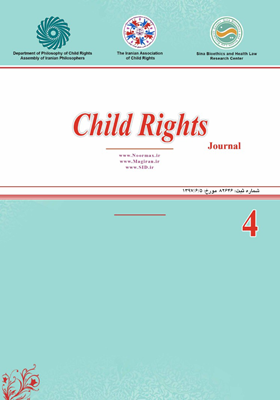Comparative Review of Criminalization of Female Circumcision in African Countries
Subject Areas : child rights
1 - Assistant Professor, Law Department, Shahed University, Tehran, Iran
Keywords: Circumcision, Girls, Africa, International Instruments, Criminalization, Punishment,
Abstract :
Female genital mutilation, sometimes referred to as female circumcision, is defined by the World Health Organization as "any act, including removing all or parts of the external area of women’s genitals or other injuries to this organ without medical justification." The female circumcision has a history of over two thousand years. Some historians attribute this to ancient Egypt circa 500 BCE. In regards to circumcision, it has been noted that it may result in loss of sexual urges and preserving chastity, but even with those assumptions the terrible effects cannot be overlooked. Female circumcision is a form of sexual violence recognized by various international organizations such as the United Nations as a harmful act and a violation of women’s rights. Today, at least two hundred million women and girls are affected in 28 African countries and parts of Asia. To counter this evil phenomenon, many African countries have joined international treaties (such as Convention on the Rights of the Child) or regional ones (such as the African Charter of the Rights and Child Welfare); secondly, they have criminalized this exercise and even being an accessory to it. However, traditional customs are a fundamental obstacle to eliminating this wrong behavior in Africa.
1. World Health Organization. Female Genital Mutilation. Geneva: Green Ink; 2018. Available at: http://www.who.int/topics/female_ genital_mutilation/en/.
2. UNICEF. Female Genital Mutilation/ Cutting: A Global Concern. New York: UNICEF Press; 2016. p.2. Available at: http://www.unicef.org/media/files/FGMC_2016_brochure_final_UNICEF_SPREAD.pdf.
3. World Health Organization. Female Genital Mutilation: Key Facts. Geneva: Green Ink; 2018. Available at: http://www.who.int/en/news-room/fact-sheets/detail/female-genital-mutilation.
4. Alison TS. Female Circumcision: A Critical Approach. Human Rights Quarterly 1988; 10(4): 439-453. Available at: https://www.jstor.org/stable/761916?seq=1#page_scan_tab_contents.
5. Kassamali N. Genital Cutting. Encyclopedia of Women & Islamic Cultures. Compiled by Najmabadi A. Tehran: BRILL; 2003.
6. UNICE. Female Genital Mutilation/ Cutting: A Statistical Overview and Exploration of the Dynamics of Change. New York: UNICEF Press; 2013. p.24. Available at: https://www.unicef.org/publications/ index_69875.html.
7. Ng F. Female genital mutilation; its implications for reproductive health. An overview. The British Journal of Family Planning 2000; 12(26): 47-51.
8. World Health Organisation. Female genital mutilation. Geneva: WHO; 2001.
9. UNICEF. Changing a harmful social convention: Female genital muilation/ cutting. New York: UNICEF Press; 2005.
10. De Bruyn M. Discussion paper: Socio-cultural aspects of female genital cutting. In Proceedings of the expert meeting on female genital mutilation. Brussel: Academic and Scientific Publishers; 2003. p.68-82.
11. Mohammad R. Cultural and social dimensions of FGM. London: Forward; 1999.
12. Gruenbaum E. The Female Circumcision Controversy: An anthropological perspective. Philadelphia: University of Pennsylvania Press; 2001.
13. Mackie G. Ending Footbinding and Infibulation: A Convention Account. American Sociological Review 1996; 61(6): 999-1017.
14. Fanid N. Offended Women Rights in Criminal Affairs Referring International Documents and Local Laws. National Women and Challenges Conference Papers. 1st ed. Gathered by Mosa Nejad A. Ilam: Barg Azin Publication; 2007. p.314.
15. Tavasoli H. Human Rights and Iran. Tehran: No Name; 2019. Available at: http://www.Kamalmesbahi.com.
16. Tang R. General Review of Feminist Theories. Translated by Najm Araghi M. 1st ed. Tehran: Nai Publication; 2008. p.362.
17. Ravasian Kashi S. Discrimination Commons (evaluation of Women Discrimination Prohibition). 1st ed. Tehtan: Shirazeh Publication; 2009. p.118.
18. Izadi M. Important Issues in Child Birth and Women Disease. 1st ed. Tehran: Parvaneh Publication; 2003. p.145-160.
19. Baseri AA. Rights of HIV Patients. 1st ed. Tehran: Khorasandi Publication; 2009. p.17-18.
20. Costello S. (Executive Director) Tradition in transition: African women discuss why they have abandoned female genital cutting [Video]. Melbourne: RMIT University; 2014.
21. World Health Organization. WHO guidelines on the management of health complications from female genital mutilation. Geneva: Green Ink; 2016. p.1-5. Available at: http://www.who.int/reproduct ivehealth/topics/fgm/management-health-complications-fgm/en/.
22. Haljin R, Cross Vitborn S. Mental Pathology. Translated by Seyed Mohammadi Y. 7th ed. Tehran: Ravan Publication; 2010. Vol.2 p.41-49.
23. Khosravi Z. Identity Psychology Fundamentals. 1st ed. Tehran: Cultural Studies and Social Plan Office; 2003. p.71-72.
24. Gholami A, Moghadami N. Possible Crimes in Female Circumcision and the Need for its Criminalization. Medical Law Journal 2018; 12(45): 59-85.


